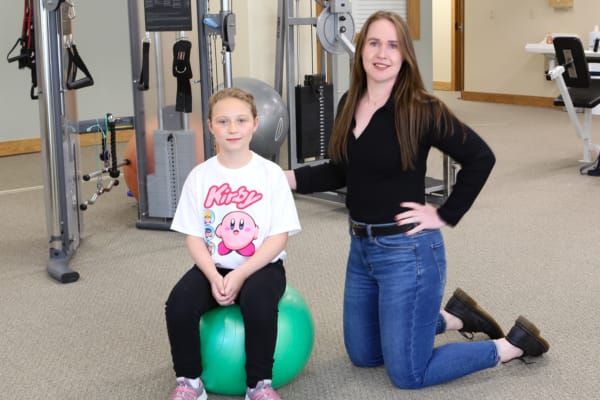Pelvic Rehabilitation
Make muscles strong and flexible again so you can get back to your routine.

Pain and other disorders of the pelvis can be embarrassing and socially isolating for women, men, and children. Fortunately, we offer compassionate and highly specialized treatment in quiet, private rooms, to help you regain the life you want to live. We use specialized physical therapy techniques to assess and treat disorders of the pelvis—especially pelvic pain, bowel/bladder dysfunction, and sexual dysfunction. Specifically, we look at the muscles of the pelvic girdle to determine if they are weak, tight, painful, in spasm, and have proper coordination.
Treatment is highly specific to each patient but may include pelvic floor relaxation and/or strengthening exercises, core muscle & breathing coordination exercises, manual techniques for trigger points or myofascial restrictions, behavioral training on toilet habits/hygiene/hydration, coordination training of the pelvic floor and pelvic girdle musculature, internal or external biofeedback/e-stim, and occasional use of modalities for pain control. Specifically, pediatric pelvic floor PT with biofeedback can retrain the pelvic floor muscles to contract, relax, and bulge or “push” —techniques that are necessary to have normal bowel and bladder functioning with no accidents!
Adult Conditions
- Abdominal or Groin Pain – pain experienced in any portion of the abdominal region or groin/inner thigh region
- Anorectal Pain – pain experienced in any portion anus or rectum present in both males and females
- Coccydynia – pain in the tailbone
- Constipation – difficulty in emptying or reduced bowel movements
- Dyspareunia – painful and oftentimes difficult intercourse
- Dyssynergic Defecation or Paradoxical Contraction – (previously known as anismus)- improper coordination of pelvic floor during defecation
- Endometriosis – painful condition where normal endometrial tissue or lesions are found outside the uterus
- Fecal Incontinence – involuntary stool leakage
- Levator Ani Syndrome – pain or discomfort in the region of the rectum, sacrum, or tailbone which can be associated or aggravated by sitting
- Incomplete Bladder Emptying – urinary retention due to obstruction or impaired bladder functioning
- Interstitial Cystitis – condition where there is inflammation or irritation of bladder wall often associated with pain or urinary symptoms
- Overactive Bladder – urinary urgency and frequency that can be associated with incontinence
- Pelvic or Genital Pain – pain experienced in any portion of the pelvic region or genital region in both males and females
- Pelvic Organ Prolapse – occurs when a pelvic organ drops from its normal position and either pushes into the wall of the vagina or protrudes towards the exterior of the body (includes cystocele or bladder prolapse, rectocele or posterior vaginal wall prolapse, uterine prolapse, urethrocele or urethral prolapse, and rectal prolapse)
- Post-surgical pain/scarring – painful scar or fascia as a result of surgeries such as C-section, abdominoplasty, prolapse surgery, hernia repair, and prostatectomy to name a few
- Pregnancy & Post-Partum Pain or Dysfunction – wide variety of conditions present during or after pregnancy (examples listed below):
- Diastasis Recti (Abdominal Separation) – separation between the two sides of the rectus abdominus muscle
- Pubic Symphysis Pain or Dysfunction – a condition that causes pain or discomfort at the pubic symphysis region often associated with excessive movement or instability
- Sacroiliac Joint Pain or Dysfunction – pain or discomfort in the joint between the sacrum and ilium often times associated with hyper- or hypo- mobility and myofascial contributions
- Low Back Pain – pain in the lower back region associated with pregnancy-related changes of the body (laxity, postural, or myofascial contributions)
- Sciatica – pain or discomfort associated with the sciatic nerve (spanning from lower back down towards the feet) often associated with pregnancy-related changes of the body
- Prostatitis – a chronic pelvic pain syndrome present in the pelvic region, penis, or testicles
- Pudendal Neuralgia – pain or discomfort in the pudendal nerve region (perineum, rectum, and/or clitoris/penis)
- Sexual Dysfunction – difficulty during any portion of normal sexual activity (such as desire, arousal, or orgasm)
- Vaginismus – spasms and contraction of the pelvic floor muscles present with entry or penetration of the vagina, often associated with pain
- Vulvodynia – pain, burning, itching, or discomfort in the vulvar region (around the opening of the vagina) often with no identifiable cause
- Urinary Incontinence – involuntary urinary leakage (includes urge, stress, and mixed incontinence)
Pediatric Conditions
- Abdominal or Groin Pain – pain experienced in any portion of the abdominal region or groin/inner thigh region
- Coccydynia – pain in the tailbone
- Constipation – difficulty in emptying or reduced bowel movements
- Dyssynergic Defecation (previously known as anismus) – improper coordination of pelvic floor during defecation
- Encopresis – involuntary loss of stool typically with stool impaction
- Enuresis – daytime urinary leakage
- Fecal Incontinence – involuntary stool leakage
- Hirschsprung Disease – condition affecting the colon resulting in problems passing stool
- Incomplete Bladder Emptying – urinary retention due to obstruction or impaired bladder functioning
- Imperforate Anus – an anorectal malformation present at birth
- Nocturnal Enuresis – night-time urinary leakage
- Urinary Incontinence – involuntary urinary leakage
